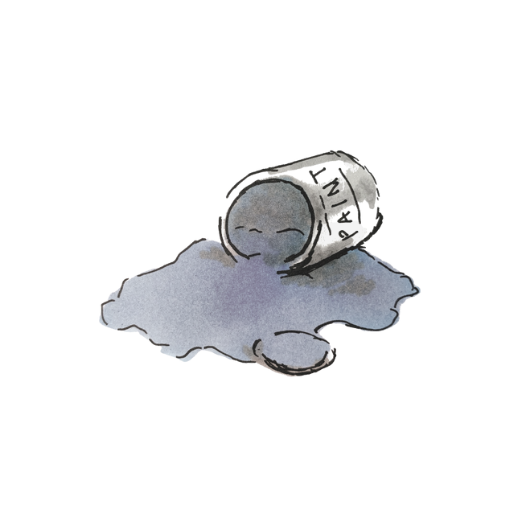
I love a good upcycle. Basically I can’t afford to buy furniture that costs hundreds of pounds. I like furniture that is affordable: i.e. from IKEA. But I love the whole French cottage style shabby chic thing for the garden room. Well, that’s fine, because this is a really easy upcycle to create a shabby chic IKEA bookshelf.
Step 1: Painting

I used a Kallax shelving unit turned on its side – it only cost £35. And as for the paint, I used left overs of whatever I had in the house.

The neutral is Rust-Oleum Universal satin furniture paint in Mocha, the blue at the bottom left is Rust-Oleum satin furniture paint in Sky Blue, the blue/green to the right is Rust-Oleum chalky-finish furniture paint in Duck Egg and the pink in the middle is a tester from Valspar matt finish in Violet Ice. It’s not pictured here, but I also used green matt paint from B&Q Colours in Guava Green, but this has been discontinued. It was just interior wall emulsion in any case. Yep, that’s right, different finishes, different makes. It works fine and chances are, you already have plenty of paint knocking about the house (and since you presumably already decorated with it, it’ll be in the right colour scheme, so why buy more?!)
To get a good finish, give the furniture a clean first with a duster. You don’t actually even need to sand the furniture down, though it is helpful to give it a once over with a fine grade sandpaper just to rough it up a bit, this should be a ten minute job as if you were giving it a quick clean; you don’t need to remove all the finish if painting over it (certainly I had no issues with the paints I used above). It’s important that the colours work harmoniously together.
Start with your base colour, which doesn’t necessarily need to be a neutral colour, but a colour that you want to be prominent. I went with duck egg, because the colour matched the wallpaper I chose to line the inside of the bookshelves.

While on the subject of wallpaper, I used this Laura Ashley Eau de Nil, which is currently in the sale.
The best thing is you don’t need to be too precise! Just whack the first coat on. As it’s a shabby chic effect, it really doesn’t matter too much if you can see some brush strokes.

Next, you need to add in the different colours – the first coat doesn’t need to be dry. You can use the same brush or different ones if you are worried about mixing the paint, but it is important not to water the paint down as that will cause the paints to blend.
Just glide the brush naturally to add in the extra colours until you build up tones you like. In the picture to the right you can see the colours starting to build up – it’s quite a subtle effect.

Once the paint has dried, use fine grade sandpaper to scruff it up. Use some long, sweeping strokes, but focus on the edges, corners and a couple of specific spots for natural looking wear and tear.
If you go too much, just add a bit more paint, as I did in the left hand corner in the picture here on the right.
Step 2: Wallpapering
First, cut down enough squares. It’s easier just to do this in one go. You can make sure they line op at the edges then more easily as well.
I used an old piece of mdf board to cut on, a metal ruler (both to measure and as a guide to cut) and a stanley knife to slice the paper – watch your fingers and use a sharp blade to help prevent snagging). Double check all your squares fit ok before moving on to gluing down. It they are a bit too small this is ok, as you will paint over the paper a little anyway to help it blend in seamlessly.It’s a good idea to give the inside of the shelves a light sand to help the wallpaper adhere. I use PVA glue. It is without doubt the best thing! Water it down a little; about three parts PVA to one part water and paint it directly onto the furniture (be generous). Apply the squares carefully but quickly and smooth out any air bubbles if you get them. Big ones can be sliced with the stanley knife to let the air out. Running the metal ruler over the paper helps stick it right down and it also helps to weight the squares down with a heavy book whilst they dry.
As you can see, I’ve lined up the pattern of each square to keep things flowing.Once all your squares are stuck on and dried, the finishing touch is to add a little more paint to create the illusion of the paint blending into the paper – as if the design is actually painted on.
Finally, once the glue is dry, get your paintbrush back and use the same colours to blend the edges. Once the paint is dry it’ll need a coat of finishing wax to seal it; I used Rust-Oleum finishing wax in clear.

And that’s it. brand new old furniture. If you have a go, please leave a comment or tag me on instagram.


